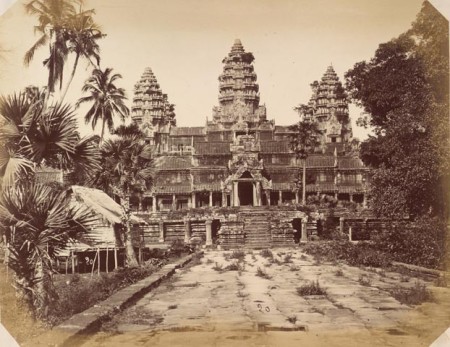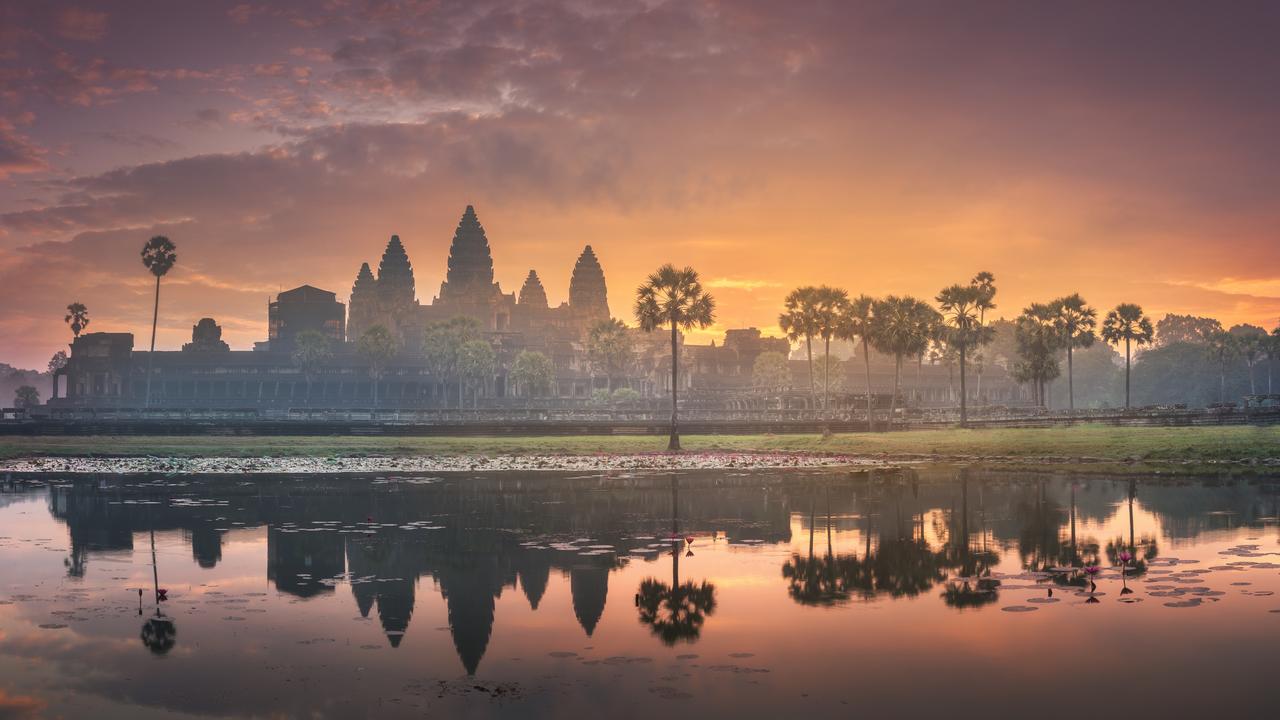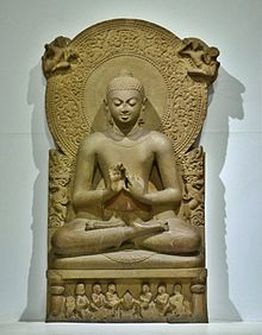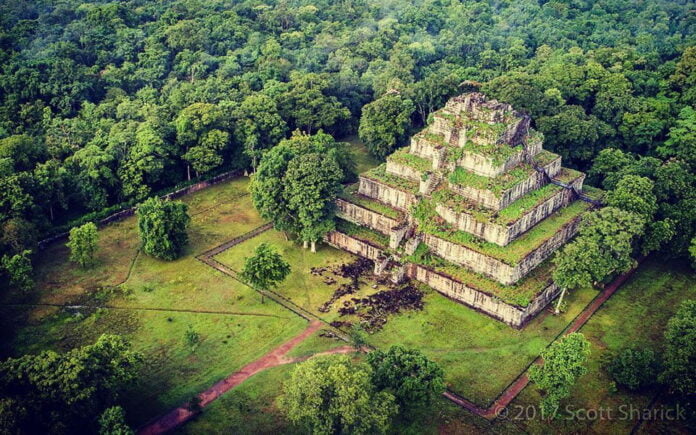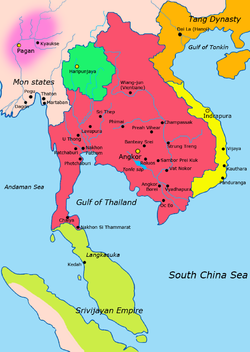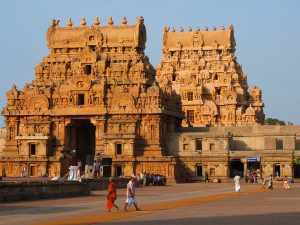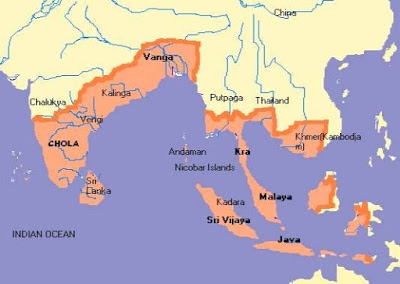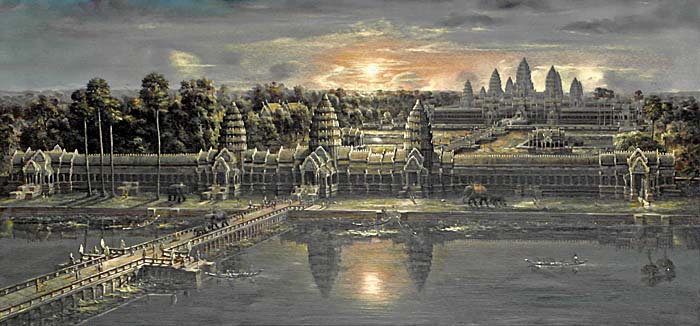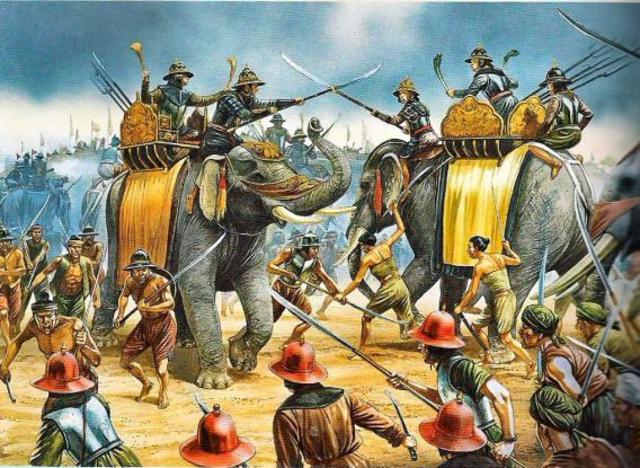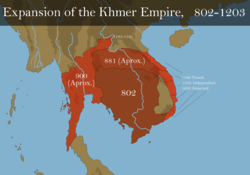The Kings of Angkor
The Kings of Angkor
The Kings of Angkor is available in both paperback and as an eBook at www.amazon.com/dp/B07N56RBXD
The Funan Kingdom was located in what is nowsouth Cambodia and south Vietnam and archaeological finds, such as Roman coins date back to the first century A.D. Evidence of trade goods, religious artifacts and Indian jewelry have been found at the southern port of Oc-Eo that evidence a powerful international trading state.
Evidence has also been found of a large canal system that served to link the major settlements within the kingdom. With lush jungle between towns and cities, communication was only practical by water.
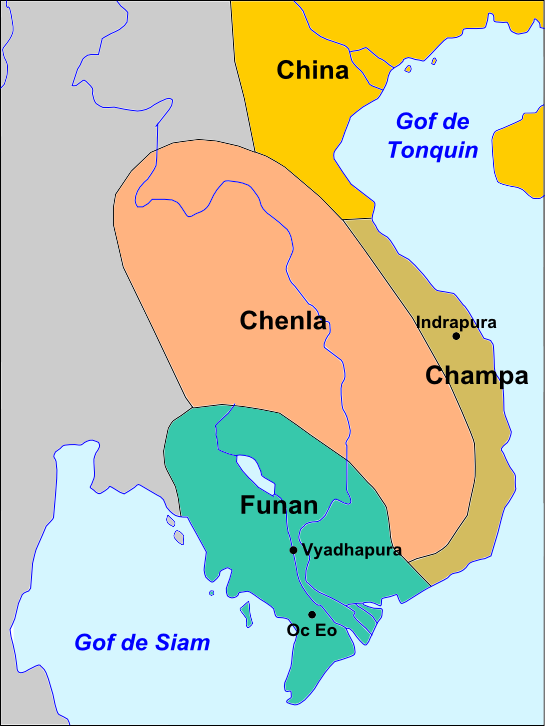
Nicolas Eynaud - Own work, CC BY-SA 4.0, https://commons.wikimedia.org/w/index.php?curid=44028538
History begins with legends. In the Khmer foundation legend an Indian Brahmin named Kaundinya married Soma, the Funan queen and that was the beginning of the dynasties of the Funanese kings. The name Funan derives from the Chinese rendition of the old Khmer word bnam (meaning mountain). Funan collapsed in the sixth century, perhaps following a change in trading patterns. Evidence shows that considerable trade was conducted with the Roman Empire. Alternatively, it could have been a reluctance to adapt to more modern agricultural ideas coming into the region. Funan was gradually incorporated into the Chenla kingdom. It was in 802 when King Jayavarman II declared himself "Chakravartin," or "Universal Monarch" at Mount Kulen, commencing the Khmer Empire. The resultant Angkor civilization marked the golden era in Cambodian history with the city of Angkor Wat becoming the largest inhabited city of its time. Its religion, history, traditions and architecture all influenced the development of Ayutthaya.
The Funan Kingdom was heavily influenced by Indian culture and traditions, as traders and Brahmin monks from the Indian subcontinent journeyed and settled. This early kingdom adopted many aspects of the Indian way of life including the use of the Sanskrit language in its legal system, the Buddhist and Hindu religions, its literature and its knowledge of astronomy. This early kingdom reached its zenith during the reign of King Fan Shihman in the early third century when its dominions stretched from present day Cambodia, Vietnam, parts of Laos, southern Thailand, and some coastal regions of Malaysia.
During the 6th century a former vassal state, Chenla, rose to prominence and gained control over its former master. One reason given to explain the decline of the Funan civilization is the collapse of the Roman Empire that brought the deterioration of the burgeoning trade routes that existed between the Mediterranean and China. As its population grew the kingdom failed to adapt and diversify into an economy that would become more reliant on agriculture, in particular the cultivation of rice. The kingdom of Chenla continued to embrace the religions and influences brought from India. Reaching its peak under King Ishavarman (612 – 628), the kingdom gradually split and fragmented over the coming decades before being reunited under King Jayavarman II.
Wood sculpture of fasting Buddha from Funan , 3rd-6th century, Honolulu Academy of Arts.
Our novel starts in the court of the Lion King, Maharaja of the Sailendra Dynasty of Java. The Borobudur is the world’s largest Buddhist shrine. It was constructed in the 8th and 9th centuries AD in Java, by the Sailendra Dynasty, a prominent Indonesian dynasty that flourished in Java after the fall of the Funan kingdom of mainland Southeast Asia.
The entire temple is in the form of a lotus, the sacred flower of Buddha. Around the circular platforms are 72 openwork stupas, each containing a Buddha statue.
In 802, at Mount Kulen, the most sacred mountain in Cambodia, King Jayavarman II was declared as Devaraja, a living god. The status conferred placed the king above, or at the pinnacle of society, and all must look up to him. In doing this King Jayavarman II ushered in the civilization that would lead to the building of the Khmer Empire and Angkor Wat.
Being revered as the "god-king", the Khmer kings were able to rule over the empire with the right of divine kingship and absolute power. This enhanced the kings ability to mobilize large manpower to serve in its military force to defend the nation, as well as the resources and ability to invade neighboring kingdoms. In addition, the kings could direct labor to maintain the extensive irrigation systems that underpinned the successful economy.
The influence of India on the Khmer people was profound. The kings surrounded themselves with the wise men or the "learned" Khmer Brahmins as their counselors. The Brahmins, who originated from India, were known to have acquire vast knowledge which were inherited from father to sons or taught only within the family. These learned Brahmins help the kings to run an efficient administration of the country, and advise on areas such as hydraulic management, military matters, and religious affairs.
A Chinese pilgrim-traveller of the Sui Dynasty, called Hsun-Tsang, arrived at King Isanavarman’s court in Chenla, and left a long report of the kingdom at its height. Hsun-Tsang’s report is full of interesting details: The prince makes his residence in the city of I-she-na (Isanapura), which contains more than twenty thousand families. In the middle of the city is a great hall where the king gives audience and holds court. The kingdom includes thirty other cities, each populated by several thousands of families, and each ruled by a governor; the titles of state officials are the same as in Lin-yi.
Opposite: Sambor Prei Kuk, Isanapura
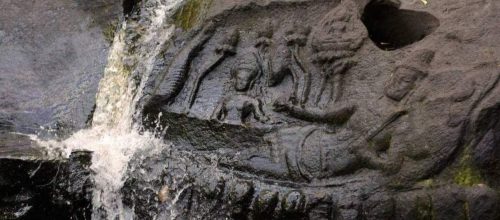
The Kulen mountains near Angkor is considered as a mecca with Cambodian people and the original birthplace of the Khmer Empire. It was here that King Jayavarman II declared independence from Java and became Devaraja, giving birth to Kambujadesa.
In 1050, King Suryavarman I, redirecred the flow of water and asked for sculpturing thousands of linga statues with carved reliefs of the Apsara God, beauty God of Laksmi. Cambodians believe that if they can bathe in this spring, then their life will be blessed with good fortune.
The Bakong is the first of the large mountain temples in Angkor and was the state temple of King Indravarman I, and was dedicated to the Hindu God Shiva. A stele found at the site states that the Bakong’s main linga named Sri Indresvara was consecrated in the temple in the year 881. The principal linga, which is a representation of Shiva, is usually enshrined in the central tower of a Khmer temple.
The Bakong, is one of the temples of the Roluos group, which includes Preah Ko and Loei. King Indravarman I, also built the huge Indratataka Baray, a reservoir where water was stored to be used for irrigation during the dry season.
The Leper King terrace is named after the “Leper King” statue that was found here. The terrace was built by Jayavarman VII in the late 12th century, directly North of the Elephant terrace.
The Leper King terrace is believed to be built as a representation of Mount Meru, the center of the universe in Buddhist and Hindu cosmology. The 25 meter long terrace is completely covered with sculptings in high relief. Long rows of seated finely carved figures, mainly of multi headed Naga snakes, armed guardians, Garudas and female celestial beings decorate the walls.The “Leper King” statue was found on top of the terrace. According to local belief, the statue was a depiction of King Yasovarman I, who was also known as the Leper King as he suffered from leprosy.
During his reign, King Yasovarman I moved the capital of his empire from Hariharalaya to the location now known as Angkor. Here, he created an enormous city of 16 square kilometers; bigger than Angkor Thom, which was built later. In the center of this city, King Yasovarman built his State Temple on top of a natural hill, known as Phnom Bakheng hill.
Phnom Bakheng is a pyramid shaped temple consisting of 7 levels, symbolizing the sacred Mount Meru and the 7 Hindu heavens. 108 towers were arranged on the ground and upper levels of the temple, symbolizing the 4 lunar phases each 27 days long. Unfortunately, most of these towers have sincecollapsed. The temple was devoted to the god Shiva and served as a tomb for King Yasovarman I.
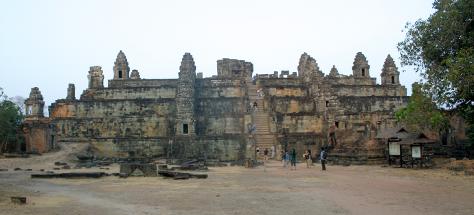
In 928, Chok Garyar (modern day Koh Ker) became the capital of the Khmer empire replacing Angkor during the reign of King Jayavarman IV. The landmark of Koh Ker is the perfect step pyramid belonging to the vast complex of King Jayavarman's state temple Prasat Thom and was originally golden.
Bottom left, the extent of the building in Koh Ker over a twenty-year period and, below, the road network linking Koh Ker with Angkor.
Bokator, considered one of the oldest existing fighting forms in Cambodia, and one that is believed to be the predecessor of all south east Asian fighting forms, is revered for its "weapons techniques". A deadly fighting tool, it is believed that Bokator was the soldier's art of the Angkorian armies, crafted to be used in the battlefield and often found on the walls of temples.
The term Bokator translates to "pounding a lion" where you extensively "pound" the opponent with your elbows, knees, shins, feet, hands and head. Weapons are employed with bamboo sticks, spears and even the krama, a traditional Cambodian scarf used in many of the tens of thousands of bokator moves. Like many of the region’s martial arts, bokator moves are based on animals, such as the tiger, horse, eagle and the naga, with the moves origins stemming from the animals’ styles. Masters will select an animal from 341 sets upon which the art is based.
Pre Rup is a three tiered pyramid temple dedicated to Shiva and was the state temple of King Rajendravarman II. It is a mountain temple build in the year 961, located just South of the large East baray and the East Mebon, another mountain temple build by King Rajendravarman II, 9 years earlier. The laterite and brick structure represents the five mountain peaks of the sacred mountain Mount Meru, the center of the universe in Hindu mythology.
The Srivijaya empire was a maritime and commercial kingdom that flourished between the 7th and the 13th centuries in what is now Indonesia. Ruled by Tamils and centered in Palembang the empire originated on the island of Sumatra.
Srivijaya’s power lay in its control of the sea lanes and the international sea trade. At its height, it ruled Western Indonesia and controlled the strategic Molucca Straits, a choke point on the India-China trade route. It was one of the largest empires in the Southeast Asia region and was largelya Buddhist empire which adhered to Mahayana Buddhism.
One of the tallest monuments of Angkor, the Ta Keo is a mountain temple built by Jayavarman V.
Its five sanctuaries are placed on top of a 22 meter high five stepped pyramid, from where there are good views of the surrounding area. The pyramid shaped Ta Keo was build to represent Mount Meru, the mountain that is the center of the world in Hindu mythology. A temple inscription says that lightning struck the temple which was taken as a sign of bad luck after which work was halted.
Map of Southeast Asia 900 AD; Khmer Empire in red Wikipedia.
Over the coming centuries the Dai-Viet would fight for their independence from China and form their own kingdom to the north of Champa (hereshown in yellow.)
The Khmer would continue to secure the area to the west fighting the local Dvarati and Mon people. The Srivijayan Empire dominated the sea lanes to the south forcing the kings of Angkor to look eastward for a trading port in the land held by the Cham.
The Phimeanakas is a small, laterite Hindu temple in the shape of a three stepped pyramid. The name Phimeanakas translates to “Celestial Palace” and building commences in the reign of King Jayavarman V and was completed in the reign of King Suryavarman I. The temple located in the center of the Royal Palace enclosure was used by King Jayavarman VII as his private temple.
Zhou Daguan, the Chinese diplomat who lived in Angkor for a year during the reign of King Jayavarman VII and kept extensive accounts, referred to the Phimeanakas as “the Golden Tower” located in the private living quarters of the King.
Opposite:The Khmer empire in the reign of King Suryavarman 1 (1010 - 1050)
King Suryavarman I, is considered a great Khmer kig of the Angkor period of Cambodian history. He was renowned as a conqueror and builder who greatly expanded his territorial holdings and consolidated the conquered lands into a strong, unified empire.
Suryavarman defeated King Udayadityavarman by 1002 and Jayaviravarman, his would-be successor, by 1010, securing the Khmer throne for himself. In contrast to his Hindu subjects, Suryavarman was a Mahayana Buddhist who, in the opinion of some scholars, considerably enhanced the prestige and influence of his religion among the Khmers and yet was tolerant of the local Vishnu cult of Hinduism.
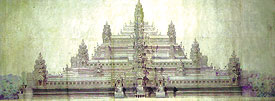
The Baphuon is the state temple of King Udayadityavarman II. It is located in the Khmer capital city of Angkor Thom, between the Royal Palace and the Prasat Bayon. The sandstone monument that was dedicated to Shiva is in the shape of a stepped pyramid. When the temple was converted into a Buddhist temple in the 15th century, part of the Baphuon was demolished and the stones used to build a Buddha image on the West end of the temple.
Reconstruction of the Bauphon by By Lucien Fournereau - Lucien Fournereau, Public Domain, 1889.
Plan of the angkorian temple Baphuon, CambodiaBy Maurice Glaize - theangkorguide.com, a free english translation of Maurice Glaize's 1944 book., Copyrighted free use, https://commons.wikimedia.org/w/index.php?curid=1045948
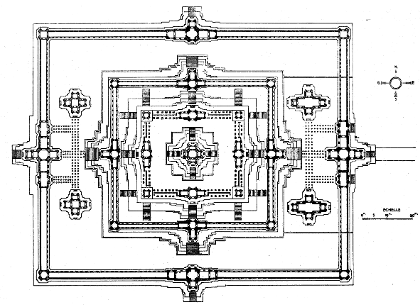
The Chola Empire rose to power after the decline of the Pallavas. They are a Tamil dynasty that ruled the whole of South India from the 9th to 13th century.
The Chola Empire was based in the Kaveri River Valley, which runs southeast through Karnataka, Tamil Nadu, and the southern Deccan Plateau to the Bay of Bengal. At its height, the Chola Empire controlled not only southern India and Sri Lanka, but also the Maldives. It took key maritime trading posts from the Srivijaya Empire and sent diplomatic and trading missions to China's Song Dynasty (960 - 1279 CE).
King Suryavarman II began construction of the greatest temple and his mausoleum: Angkor Wat; he chose the Hindu God Vishnu as his patron. The king was treated as a god on Earth by his people and had all the power of government. He made Angkor the biggest city in the world with glorious temples, monuments and grandeur. Conflict with the Dai Viet and Champa kingdoms to the east occupied much of King Suryavarman's later reign, and those conflicts would ultimately endanger Angkor Wat itself.
Angkor Wat is the most recognizable a temple complexes and is one of the largest religious monuments in the world, on a site measuring 162.6 hectares. It was originally constructed as a Hindu temple dedicated to the god Vishnu, gradually transforming into a Buddhist temple towards the end of the 12th century. The temple, built in the reign of King Suryavarman II, represents Mount Meru, the spiritual home of the Hindi Gods. The five towers embody the five peaks of Mount Meru, the outer-walls symbolize the mountains that surround Mount Meru and the moat signifies the world's oceans.
The Battle of Tonle Sap was a war between the Cham, in particular, the Panduranga led by General Po Klong Garai in 1177. A Cham/Panduranga fleet sailed up the Tonle Sap River and onto the great Tonle Sap Lake just south of the capital city. Naval and land battles ensued in which the city was assaulted, burned and occupied by the Cham. The usurper king, King Tribhuvanadityavarman was killed, and the Cham ruled Angkor for four years before being driven out by King Jayavarman VII and ushering the reign regarded as the pinnacle of the Khmer Empire.
Above: The Battle of Tonle Sap
In 1181, King Jayavarman VII launched a military campaign against the Cham, as vengeance for the conquest of Angkor in 1177, and to finally defeat one of their traditional enemies. Leading a powerful army, Jayavarman VII repelled the Cham from Angkor, and attacked Champa,to finally defeat them. The conquest of Champa gave Jayavarman VII the highest position of God-King, and sparked his rule as one of the greatest achieving Khmer kings. Recreations opposite)
(Source: Weapons and Warfare)
After securing the throne King Jayavarman VII’s building campaign was unprecedented and took place at a frenetic pace. Hundreds of monuments were constructed in less than a 40-year period. Jayavarman VII’s works included the Bayon with its famous giant faces, his capital city of Angkor Thom, the temples of Ta Prohm, Banteay Kdei and Preah Khan, and hundreds of others.
Opposite: The faces of the Bayon
Jayavarman VII’s prodigious building campaign also represents the finale of the Khmer empire as no further grand monuments were constructed after his death in 1220. Construction on some monuments, notably the Bayon, stopped short of completion, probably coinciding with Jayavarman VII’s death. King Jayavarman VIII continued construction on some of King Jayavarman VII monuments.
Opposite: The entrance to Angkor Thom
Angkor Thom, "The Greatest City," is best-known for its 148-foot centric temple, called the Bayon. Entering by the southern gate the road is lined with mythical creatures and gods said to be vying with the Khmer for the “sea of milk” that was believed to be the key to the genesis of the world. The gates of Angkor Thom illustrate intricate carvings of the head of King Jayavarman VII.
At the Bayon throughout the first level there are ornate reliefs together with the Terrace of Elephants and Terrace of the Leper King. King Jayavarman VII was said to have used the Terrace of the Elephants within Angkor Thom as a viewing stage during troop reviews, elephant processions, and parties.
Opposite: The expansion of the Khmer Empire. At its largest extent, ranging from the Burmans in the west and encompassing modern-day Thailand. The empire held the north of the Malay Peninsula where the military stronghold of Ligor was based. To its east were the kingdoms of the Dai-Viet and Champa. The Dai-Viet eventually overcame the Cham forming the boundaries of modern-day Vietnam.
Zhou Daguan, a Chinese envoy who visited Angkor in 1296-97 wrote the only first-hand account of the civilization of Angkor. His descriptions of the royal palaces, temples, people, customs, traders, slaves, and everyday life presents a unique perspective of the life in thirteenth-century Angkor just before the Empire slid into gradual decline. Opposite: Angkor pictured in 1866/
